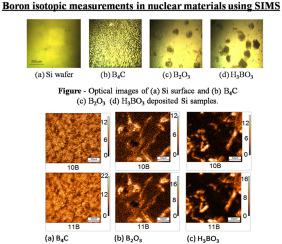当前位置:
X-MOL 学术
›
Int. J. Mass Spectrom.
›
论文详情
Our official English website, www.x-mol.net, welcomes your
feedback! (Note: you will need to create a separate account there.)
Development of methodology for determining the isotopic composition of boron in powder and solid nuclear materials using secondary ion mass spectrometer
International Journal of Mass Spectrometry ( IF 1.6 ) Pub Date : 2021-02-01 , DOI: 10.1016/j.ijms.2020.116475 V. Karki , M. Singh , K. Sasi Bhushan , R.M. Rao , P.G. Jaison
International Journal of Mass Spectrometry ( IF 1.6 ) Pub Date : 2021-02-01 , DOI: 10.1016/j.ijms.2020.116475 V. Karki , M. Singh , K. Sasi Bhushan , R.M. Rao , P.G. Jaison

|
Abstract A method has been developed to determine the isotopic composition of boron (10B/11B) in powder and solid nuclear materials using secondary ion mass spectrometry (SIMS). Isotopic composition of boron in standard sample matrices such as H3BO3, B2O3, B4C (powder) and TiB2 (solid alloy) were measured by the method and compared with the isotopic composition determined from thermal ionization mass spectrometer. Powder samples were ultrasonicated in Milli-Q water and the solutions/slurry obtained were deposited on cleaned silicon wafers, dried under halogen lamp and analyzed by SIMS whereas solid alloy sample TiB2 was directly analysed after mechanical polishing and cleaning. Detailed analyses have been carried out using both oxygen and cesium primary ion beams under different analysis conditions. Various elemental and molecular secondary ions were monitored for determining the isotopic composition of boron present in the samples. Standard of boron, NIST-SRM-951 sample was utilized for determining the instrument bias correction factor for different primary beam analysis conditions. The determined instrument bias correction factor was then utilized to measure the isotopic composition of boron in other samples. Surface distribution analysis was also carried out to determine the isotopic distribution of boron deposited on Si wafers. Determination of boron isotopic ratio in refractory nuclear materials (B4C, TiB2) using this method requires minimal sample preparation and avoids commonly used complex dissolution process.
中文翻译:

开发使用二次离子质谱仪测定粉末和固体核材料中硼同位素组成的方法
摘要 开发了一种使用二次离子质谱法 (SIMS) 测定粉末和固体核材料中硼 (10B/11B) 同位素组成的方法。用该方法测量了标准样品基质如 H3BO3、B2O3、B4C(粉末)和 TiB2(固体合金)中硼的同位素组成,并与热电离质谱仪测定的同位素组成进行了比较。粉末样品在 Milli-Q 水中进行超声处理,所得溶液/浆液沉积在清洁的硅片上,在卤素灯下干燥并通过 SIMS 进行分析,而固体合金样品 TiB2 在机械抛光和清洁后直接进行分析。在不同分析条件下使用氧和铯初级离子束进行了详细分析。监测各种元素和分子次级离子以确定样品中硼的同位素组成。硼标准,NIST-SRM-951 样品用于确定不同主光束分析条件下的仪器偏差校正因子。然后利用确定的仪器偏差校正因子来测量其他样品中硼的同位素组成。还进行了表面分布分析以确定沉积在硅晶片上的硼的同位素分布。使用这种方法测定耐火核材料(B4C、TiB2)中的硼同位素比需要最少的样品制备并避免常用的复杂溶解过程。NIST-SRM-951 样品用于确定不同主光束分析条件下的仪器偏差校正因子。然后利用确定的仪器偏差校正因子来测量其他样品中硼的同位素组成。还进行了表面分布分析以确定沉积在硅晶片上的硼的同位素分布。使用这种方法测定耐火核材料(B4C、TiB2)中的硼同位素比需要最少的样品制备,并且避免了常用的复杂溶解过程。NIST-SRM-951 样品用于确定不同主光束分析条件下的仪器偏差校正因子。然后利用确定的仪器偏差校正因子来测量其他样品中硼的同位素组成。还进行了表面分布分析以确定沉积在硅晶片上的硼的同位素分布。使用这种方法测定耐火核材料(B4C、TiB2)中的硼同位素比需要最少的样品制备并避免常用的复杂溶解过程。还进行了表面分布分析以确定沉积在硅晶片上的硼的同位素分布。使用这种方法测定耐火核材料(B4C、TiB2)中的硼同位素比需要最少的样品制备并避免常用的复杂溶解过程。还进行了表面分布分析以确定沉积在硅晶片上的硼的同位素分布。使用这种方法测定耐火核材料(B4C、TiB2)中的硼同位素比需要最少的样品制备并避免常用的复杂溶解过程。
更新日期:2021-02-01
中文翻译:

开发使用二次离子质谱仪测定粉末和固体核材料中硼同位素组成的方法
摘要 开发了一种使用二次离子质谱法 (SIMS) 测定粉末和固体核材料中硼 (10B/11B) 同位素组成的方法。用该方法测量了标准样品基质如 H3BO3、B2O3、B4C(粉末)和 TiB2(固体合金)中硼的同位素组成,并与热电离质谱仪测定的同位素组成进行了比较。粉末样品在 Milli-Q 水中进行超声处理,所得溶液/浆液沉积在清洁的硅片上,在卤素灯下干燥并通过 SIMS 进行分析,而固体合金样品 TiB2 在机械抛光和清洁后直接进行分析。在不同分析条件下使用氧和铯初级离子束进行了详细分析。监测各种元素和分子次级离子以确定样品中硼的同位素组成。硼标准,NIST-SRM-951 样品用于确定不同主光束分析条件下的仪器偏差校正因子。然后利用确定的仪器偏差校正因子来测量其他样品中硼的同位素组成。还进行了表面分布分析以确定沉积在硅晶片上的硼的同位素分布。使用这种方法测定耐火核材料(B4C、TiB2)中的硼同位素比需要最少的样品制备并避免常用的复杂溶解过程。NIST-SRM-951 样品用于确定不同主光束分析条件下的仪器偏差校正因子。然后利用确定的仪器偏差校正因子来测量其他样品中硼的同位素组成。还进行了表面分布分析以确定沉积在硅晶片上的硼的同位素分布。使用这种方法测定耐火核材料(B4C、TiB2)中的硼同位素比需要最少的样品制备,并且避免了常用的复杂溶解过程。NIST-SRM-951 样品用于确定不同主光束分析条件下的仪器偏差校正因子。然后利用确定的仪器偏差校正因子来测量其他样品中硼的同位素组成。还进行了表面分布分析以确定沉积在硅晶片上的硼的同位素分布。使用这种方法测定耐火核材料(B4C、TiB2)中的硼同位素比需要最少的样品制备并避免常用的复杂溶解过程。还进行了表面分布分析以确定沉积在硅晶片上的硼的同位素分布。使用这种方法测定耐火核材料(B4C、TiB2)中的硼同位素比需要最少的样品制备并避免常用的复杂溶解过程。还进行了表面分布分析以确定沉积在硅晶片上的硼的同位素分布。使用这种方法测定耐火核材料(B4C、TiB2)中的硼同位素比需要最少的样品制备并避免常用的复杂溶解过程。









































 京公网安备 11010802027423号
京公网安备 11010802027423号